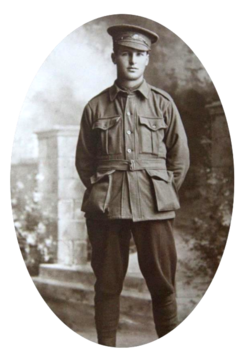HAY, Colin
| Service Number: | 1665 |
|---|---|
| Enlisted: | 26 February 1916, Melbourne, Vic. |
| Last Rank: | Private |
| Last Unit: | 39th Infantry Battalion |
| Born: | Mount Gambier, South Australia, Australia, 18 May 1895 |
| Home Town: | Mount Gambier, Mount Gambier, South Australia |
| Schooling: | Mount Gambier High School |
| Occupation: | Baker |
| Died: | 13 December 1960, aged 65 years, cause of death not yet discovered, place of death not yet discovered |
| Cemetery: |
Eastern Suburbs Memorial Park, NSW Rose Gardens, Garden K3, Position 255 |
| Memorials: | Mount Gambier High School Great War Roll of Honor, Mount Gambier St. Andrew's Presbyterian Church Roll of Honor (2), New South Wales Garden of Remembrance (Rookwood Necropolis) |
World War 1 Service
| 26 Feb 1916: | Enlisted AIF WW1, Private, 1665, 39th Infantry Battalion, Melbourne, Vic. | |
|---|---|---|
| 27 May 1916: | Involvement Private, 1665, 39th Infantry Battalion, --- :embarkation_roll: roll_number: '18' embarkation_place: Melbourne embarkation_ship: HMAT Ascanius embarkation_ship_number: A11 public_note: '' | |
| 27 May 1916: | Embarked Private, 1665, 39th Infantry Battalion, HMAT Ascanius, Melbourne |
Help us honour Colin Hay's service by contributing information, stories, and images so that they can be preserved for future generations.
Add my storyBiography contributed by Graeme Roulstone
1665 Colin HAY was born at Mount Gambier on 18 May 1895. He was enrolled at Mount Gambier High School on 9 October 1910 by his father James Hay, a labourer, of Bertha Street, Mount Gambier. He left school on 31 December 1908.
He enlisted in Melbourne on 26 February 1916 (21, baker, single, Protestant) naming his father James Hay of Kongorong, South Australia, as his next of kin. He embarked from Melbourne on the ‘Ascanius’ on 27 May 1916 and disembarked at Devonport in England on 18 July 1916 where he was attached to the 10th Training Battalion.
He was sent to France on 12 December 1917, joining the 39th Battalion on 19 December but was transferred to the 10th Light Trench Mortar Battery on 22 January 1918. Wounded at Heilly in France on 28 March 1918 (compound fracture left ankle), he was invalided to England dangerously ill on 13 April where his leg was amputated. He was on furlough from 24 August to 7 September 1918. He left England for return to Australia on the ‘Bahia Castillo’, disembarked on 17 April 1920, and was discharged from the AIF on 19 June. He returned to Mount Gambier on Friday 11 March 1921, having ‘arrived in Melbourne from England some eight months ago.’









